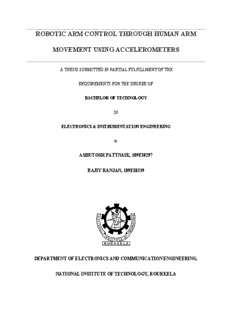Table Of ContentROBOTIC ARM CONTROL THROUGH HUMAN ARM
MOVEMENT USING ACCELEROMETERS
A THESIS SUBMITTED IN PARTIAL FULFILLMENT OF THE
REQUIREMENTS FOR THE DEGREE OF
BACHELOR OF TECHNOLOGY
IN
ELECTRONICS & INSTRUMENTATION ENGINEERING
by
ASHUTOSH PATTNAIK, 109EI0297
RAJIV RANJAN, 109EI0339
DEPARTMENT OF ELECTRONICS AND COMMUNICATION ENGINEERING,
NATIONAL INSTITUTE OF TECHNOLOGY, ROURKELA
ROBOTIC ARM CONTROL THROUGH HUMAN ARM
MOVEMENT USING ACCELEROMETERS
A THESIS SUBMITTED IN PARTIAL FULFILLMENT OF THE
REQUIREMENTS FOR THE DEGREE OF
BACHELOR OF TECHNOLOGY
IN
ELECTRONICS & INSTRUMENTATION ENGINEERING
by
ASHUTOSH PATTNAIK, 109EI0297
RAJIV RANJAN, 109EI0339
UNDER THE SUPERVISION OF
PROF. SANTOS KUMAR DAS
DEPARTMENT OF ELECTRONICS AND COMMUNICATION ENGINEERING,
NATIONAL INSTITUTE OF TECHNOLOGY, ROURKELA
NATIONAL INSTITUTE OF TECHNOLOGY,
ROURKELA
CERTIFICATE
This is to certify that the project report titled “ Robotic Arm Control Through Human Arm
Movement using Accelerometers ” submitted by Ashutosh Pattnaik (Roll No: 109EI0297)
and Rajiv Ranjan (Roll No: 109EI0339) in the partial fulfillment of the requirements for the
award of Bachelor of Technology Degree in Electronics and Instrumentation Engineering during
session 2009-2013 at National Institute of Technology, Rourkela and is an authentic work carried
out by them under my supervision and guidance.
Date:
Prof. Santos Kumar Das
Department of Electronics & Communication Engineering,
National Institute of Technology, Rourkela
ACKNOWLEDGEMENT
We would like to express my deep sense of gratitude and respect to my supervisor Prof. Santos
Kumar Das for his excellent guidance, suggestions and support. I consider myself extremely
lucky to be able to work under the guidance of such a dynamic personality. We would like to
render heartiest thanks to my friend who’s ever helping nature and suggestion has helped us to
complete this present work.
We would like to thank all faculty members and staff of the Department of Electronics and
Communication Engineering, N.I.T. Rourkela for their extreme help throughout course. An
assemblage of this nature could never have been attempted without reference to and inspiration
from the works of others whose details are mentioned in the reference section. We acknowledge
our indebtedness to all of them.
Ashutosh Pattnaik ( 109EI0297 )
Rajiv Ranjan (109EI0339 )
i
ABSTRACT
In today’s world there is an increasing need to create artificial arms for different inhuman
situations where human interaction is difficult or impossible. They may involve taking readings
from an active volcano to diffusing a bomb. Here we propose to build a robotic arm controlled
by natural human arm movements whose data is acquired through the use of accelerometers. For
proper control mechanism and to reduce the amount of noise coming in from the sensors, proper
averaging algorithm is used for smoothening the output of the accelerometer. The development
of this arm is based on ATmega32 and ATmega640 platform along with a personal computer for
signal processing, which will all be interfaced with each other using serial communication.
Finally, this prototype of the arm may be expected to overcome the problem such as placing or
pickinghazardous objects or non-hazardous objects that are far away from the user.
ii
CONTENTS
ACKNOWLEDGEMENT i
ABSTRACT ii
Chapter 1 : INTRODUCTION 1
1.1 Introduction 2
1.2 Robotic arm definition 2
1.3 Literature Review 3
1.4 Project Overview 4
Chapter 2 : HARDWARE DESIGN AND DESCRIPTION 5
2.1 Hardware Requirements 6
2.2 Accelerometer 6
2.3 Servo Motors 9
2.4 ATmega32 Microcontroller 10
2.4.1 USART Interface 12
2.4.2 Analog to Digital Converter (ADC) 12
2.5 ATmega640 Microcontroller 13
2.5.1 Timer 16
2.5.2 USART Interface 17
2.6 16x2 LCD Module 17
2.7 Hardware Design 18
Chapter 3 : SOFTWARE DESCRIPTION 20
3.1 Software Requirements 21
iii
3.2 Software for programming and dumping on the microcontrollers 21
3.3 Software for Signal Processing and Actuation of the servo motors 23
3.4 Software Design 23
Chapter 4 : IMPLEMENTATION 25
4.1 Implementation 26
4.2 Data Acquisition, Processing and Calibration 30
4.2.1 Data Acquisition 30
4.2.2 Data Processing 31
4.2.3 Calibration of the Servo Motors 34
Chapter 5 : CONCLUSION AND FUTURE SCOPE 36
5.1 Conclusion 37
5.2 Future Scope 37
BIBLIOGRAPHY 38
iv
LIST OF FIGURES
Fig1. Block Diagram Representation of the Proposed Robotic Arm System 3
Fig2. Simplified Accelerometer Functional Block Diagram 8
Fig3. Pin Configuration of ATmega32 11
Fig4. Pin Configuration of ATmega640 15
Fig5. LCD Pin Configuration and Connections 17
Fig6. Circuit diagram for the data acquisition from the sensor via ATmega32 18
Fig7. Circuit diagram for the control of servo motors via ATmega640 19
Fig8. Screenshot of AVR Studio 4 running on Windows 7 platform 21
Fig9. Screenshot of SinaProg 2.0 running on Windows 7 platform 22
Fig10. Screenshot of MATLAB v7.6 (R2012a) running on Windows 7 platform 23
Fig11. Block Diagram of the implemented system with signal information 24
Fig12. (a) Physical Implementation of the system; (b) Robotic Arm Only 26
Fig13. (a) Implementation of the Shoulder to Elbow Joint; (b) Implementation of the 27
Elbow to Wrist Joint
Fig14. Shoulder Joint Motors (M1 and M2) 28
Fig15. Elbow Joint Motors (M3, M4 and M5) 28
Fig16. (a) ATmega32 (b) ATmega640 Development Board 29
Fig17. (a) Real time plot when accelerometer is kept constant; (b) Real time plot 30
when accelerometer is in rotation in both anti clockwise and clockwise
direction.
Fig18. Original Input Plot of accelerometer data 32
v
Fig19. Smoothened Output Plot of accelerometer data when N = 5 32
Fig20. Smoothened Output Plot of accelerometer data when N = 10 33
Fig21. Smoothened Output Plot of accelerometer data when N = 15 32 33
vi
LIST OF TABLES
Table1. Table containing the Timer Register Values for the reference positions taken 35
during calibration.
vii
Description:or mobile (i.e. wheeled) and can be designed for industrial or home applications.
This Project represents a simple accelerometer controlled robotic arm using

